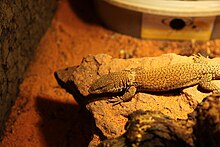Kings' monitor
| Kings' monitor | |
|---|---|

| |
| Scientific classification | |
| Domain: | Eukaryota |
| Kingdom: | Animalia |
| Phylum: | Chordata |
| Class: | Reptilia |
| Order: | Squamata |
| Family: | Varanidae |
| Genus: | Varanus |
| Subgenus: | Odatria |
| Species: | V. kingorum
|
| Binomial name | |
| Varanus kingorum | |
Kings' monitor (Varanus kingorum), also known commonly as Kings' goanna, Kings' rock monitor, and the pygmy rock monitor, is a small species of monitor lizard in the family Varanidae. The species is native to Australia.
Geographic range
[edit]V. kingorum is endemic to the northwestern part of the Northern Territory, and the adjacent northeastern part of Western Australia.
Taxonomy
[edit]The original description of V. kingorum as a species new to science was published in 1980, the result of a revision of Western and Central Australian varanid taxa.[3]
Kings' monitor belongs to the subgenus Odatria[4] along with the peacock monitor and the Pilbara monitor. Comparatively little is known about this species.[5]
The holotype was collected beneath rocks in 1978 at Timber Creek in the Northern Territory by Max King.
Etymology
[edit]The specific name, kingorum (genitive plural), is in honour of Canadian-born Australian ecologist Richard Dennis King (1942–2002) and Australian geneticist Max King (born 1946),[6] honouring their contributions to the understanding of Australia varanids.[3]
Habitat
[edit]Kings' goanna inhabits rocky outcrops of the Kimberley region and adjacent areas.[7] It is usually found in areas with rock exfoliations or slopes with open bushland and shrubs, where boulders and outcrops provide its required microhabitat.[8] V. kingorum is also found in grasslands.[9]
Description
[edit]V. kingorum is one of the smallest species of its genus, reaching a total length (including tail) of up to 40 cm (16 in).[7] It is reddish brown in colour with a black reticulum in the juvenile that breaks down with age to form dark flecks.[5] Small blackish spots appear at most parts of the dark upper body, and at the throat and near the vent against the creamy colour of the underparts.[3]
Behaviour
[edit]Kings' monitor retreats into holes, rock fissures, and small crevices when it is approached, being extremely shy.[8]
This species has a long tail that is sometimes used to prod prey out of tight, inaccessible crevices. Such is a behaviour demonstrated by both adults and hatchlings alike, and as such is likely instinctual rather than learned.[10]
Reproduction
[edit]V. kingorum is oviparous. The incubation period of the eggs ranges from 89 to 126 days at a temperature of 29 +/- 2 °C.[10]
Diet
[edit]V. kingorum appears to feed exclusively on insects, including locusts, termites, and insect eggs.[5]
References
[edit]- ^ Shea, G.; Cogger, H.; Woinarski, J.C.Z. (2018). "Varanus kingorum". IUCN Red List of Threatened Species. 2018: e.T83778181A101752335. doi:10.2305/IUCN.UK.2018-1.RLTS.T83778181A101752335.en. Retrieved 20 November 2021.
- ^ "ITIS.gov". Retrieved 11 May 2010.
- ^ a b c Storr, G.M. (1980). "The monitor lizards (genus Varanus Merrem, 1820) of Western Australia". Records of the Western Australian Museum. 8 (2): 237–293. (Varanus kingorum, new species, pp. 268–269).
- ^ * Kingsnake.com Viewed 12 May 2010
- ^ a b c Mampam.com Viewed 12 May 2010
- ^ Beolens, Bo; Watkins, Michael; Grayson, Michael (2011). The Eponym Dictionary of Reptiles. Baltimore: Johns Hopkins University Press. xiii + 296 pp. ISBN 978-1-4214-0135-5. (Varanus kingorum, p. 141).
- ^ a b Species Varanus kingorum at The Reptile Database www.reptile-database.org. (Retrieved 31 August 2024)
- ^ a b "Reptilob.de".
- ^ Varanus.nl
- ^ a b Patanant, Kidan (December 2012). "Heads You Lose, Tails You Win: Notes on a Tail-assisted Foraging Behavior in Varanus (Odatria) kingorum ". BIAWAK Journal of Varanid Biology and Husbandry. 6: 74–77 – via ResearchGate.
External links
[edit]Further reading
[edit]- Bennet DF (2003). "Australische Warane ". Reptilia (Münster) 8 (5): 18–25. (in German).
- Bennet DF (2003). "Australian Monitors". Reptilia (GB) (30): 12–19.
- Cogger HG (2000). Reptiles and Amphibians of Australia, Sixth Edition. Sanibel Island, Florida: Ralph Curtis Publishing. 808 pp.
- De Lisle HF (1996). Natural History of Monitor Lizards. Malabar, Florida: Krieger.
- Eidenmüller B (2003). "Haltung und kontinuierliche Vermehrung von Kings Felsenwaran, Varanus kingorum STORR 1980, mit der erstmaligen Nachzucht eines albinotischen Jungtieres ". Reptilia (Münster) 8 (5): 36–40. (in German).
- Eidenmüller B (1999)."Haltung und Nachzucht von Kings Felsenwaran, Varanus kingorum STORR 1980 ". Herpetofauna 21 (121): 19–23. (in German).
- Eidenmüller B (2001). "Between the rocks – Pick up tips on breeding and keeping King’s rock monitors (Varanus kingorum)". Reptiles 9 (5): 78–81.
- Eidenmüller B (2007). "Small monitors in the terrarium". Reptilia (GB) (50): 12–19.
- Horn HG (1977). "Notizen zur Systematik, Fundortangaben und Haltung von Varanus (Varanus) karlschmidti". Salamandra 13 (2): 78–88. (in German).

